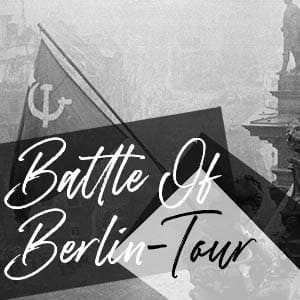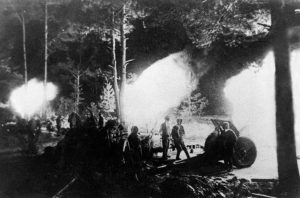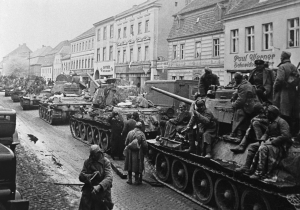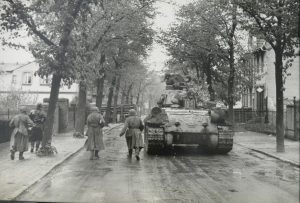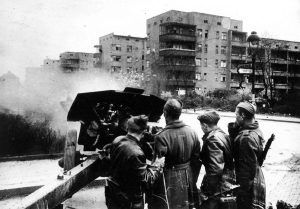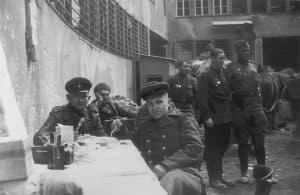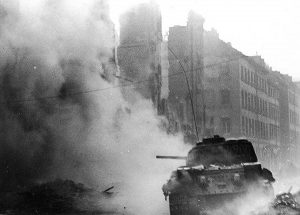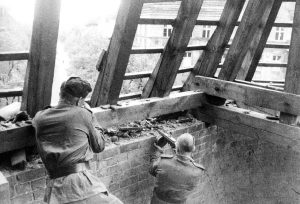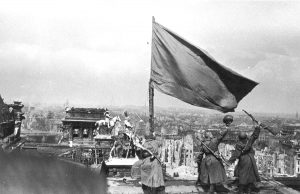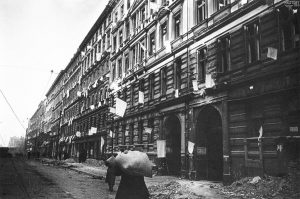At around 8:30am on May 2nd 1945 – the two Soviet army groups involved in the Battle of Berlin – the 1st Belorussian and the 1st Ukrainian – finally met at their interfront boundary on Savignyplatz. Two tank armies convened where the German Müncheberg Panzer Division had been holding ground before its attempted breakout the previous night.
This small square on Kantstrasse is still a vibrant part of the Charlottenburg district of west Berlin – an area that saw an influx of Russian refugees in the early 20th century. Some fleeing persecution, as eastern European jews – others literary exiles such as Boris Pasternak and Vladimir Nabokov. Members of the intellectual class of Russian that fled the country following the 1917 Bolshevik revolution who would settle in this neighbourhood – earning it the title of Charlottengrad due to its abundance of Russian speakers.
Now the soldiers of the Motherland were on the streets of the Nazi capital. Bringing with them the ideology that many in Charlottengrad had fled from. The Bolshevik Stalinist system that now connected distant Vladivostok to the Elbe. Most of the soldiers on the streets would be too young to remember anything before the Soviet Union. Many of them had lived the past 28 years under the paternal gaze of Comrade Stalin.
Now the flag of revolution was draped all the way across the European continent – from Moscow to Berlin – and the red banner flew high over the Reichstag.
Across the city – with Adolf Hitler dead and many of the city’s remaining defenders now attempting to navigate their way through the Soviet lines – the official announcement to surrender was being prepared.

The responsibility fell on General Helmuth Weidling, who had been in charge of the LVI Panzer Corps at the Seelow Heights before being sentenced to death in absentia and eventually resurrected to serve as the last Commander of the Berlin Defence Area on April 24th.
Weidling had surrendered with his staff some two hours early and was now in the process of arranging for the capitulation of the city’s remaining defenders.
The death of Hitler two days earlier had not meant the end of the war in Europe; nor had it meant the end of the battle of Berlin. As the senior commander in the city, it fell on Weidling to finally put an end to hostilities in the Nazi capital.
After brief formalities, he sat down at 8th Guards Army headquarters at Schulenburgring on the west side of Tempelhof airport and composed a formal order:
“On the 30th April the Führer, to whom we had all sworn an oath of allegiance, forsook us by committing suicide. Faithful to the Führer, you German soldiers were prepared to continue the battle for Berlin even though your ammunition was running out and the general situation made further resistance senseless.
I now order all resistance to cease immediately. Every hour you go on fighting adds to the terrible suffering of the Berlin population and our wounded. In agreement with the High Command of the Soviet Forces, I call on you to stop fighting forthwith.
Weidling
General of Artillery
Former Commander Berlin Defence Area”
He was then driven to a Soviet propaganda office in Johannisthal, where he recorded his order for surrender, to be broadcast from loudspeakers attached to vans driven around the city.
Although hostilities were supposed to cease at 1pm – Soviet artillery would continue to pound parts of Berlin for another two hours before falling silent.
The final defenders in the centre of the city would then lay down their arms at around 5pm on May 2nd 1945.
The defiant proclamation made by the German Army High Command over the radio the same day would differ greatly in tone to Weidling’s order:
“At the head of the heroic defenders of the Reich Capital the Führer died in action. Actuated by the will of the people and Europe from the destruction by the Bolshevists he sacrificed his life. This pattern, faithful to the death, is binding for all soldiers. The remnants of the brave garrison of Berlin, split in various battle formations continue their fight in the governmental section.”
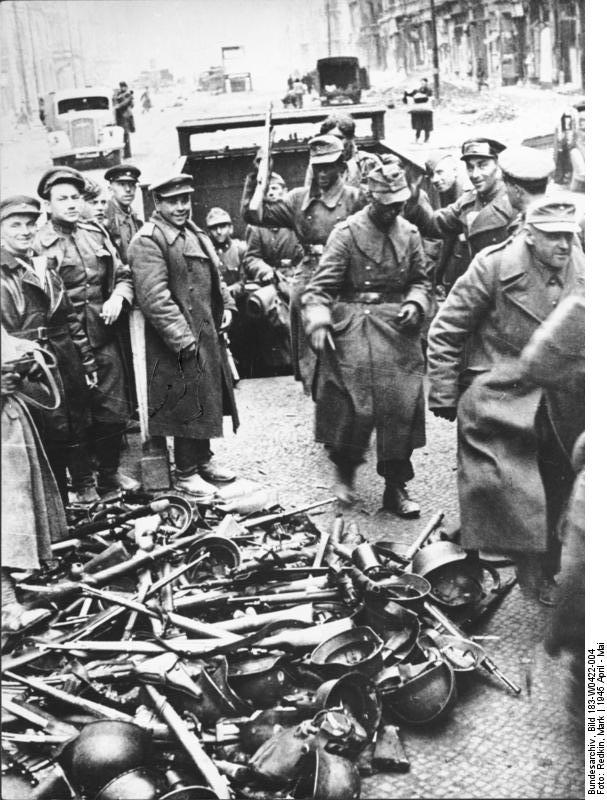
The highest ranking member of the Nazi Party left in the city – Dr Hans Fritzsche, the Permanent Under-Secretary at the Propaganda Ministry was also busy announcing the surrender of the city to the Soviets. Fritzsche was present in the Führerbunker for the final days of Adolf Hitler’s rule, and considered the most prominent radio commentator in the country. Following the death of Hitler and Goebbels, Fritzsche decided to send a delegation to the Soviets with a letter from him and request that he be allowed to broadcast to the public and confirm the end to the hostilities.
Although the Soviets were primarily concerned with the military surrender of the city – concluded by Weidling – Fritzsche was similarly taken away by escort on the morning of May 2nd to a radio station to broadcast his plea.
The final pockets of resistance in the city centre were either overrun or surrendered on May 2nd.
Fighting in the Alexanderplatz U-bahn station finally came to its bloody conclusion. The cells of the SS-Gestapo headquarters on Prinz-Albrecht-Strasse were broken open and prisoners freed by Red Army troops. The 12th Guards Rifle Corps was sent on the offensive for the first time to eliminate any remaining resistance in the area of the two Flak towers of Humboldthain and Friedrichshain that were still in German hands on the morning of May 2nd.
Although the city centre would soon fall silent – the final fighting in Berlin would take place on the Wannsee island, where Kampfgruppe Todt continued to hold out until May 3rd, and the nearby Glienicke Bridge, as small groups of SS men tried to escape towards Potsdam.
Prominently featured in the memoirs of a number of senior Soviet commanders, including Marshal Georgy Zhukov, is the record of fighting at the Reich Chancellery – Hitler’s office – on May 2nd 1945. These accounts have no doubt been greatly exaggerated as the only remaining officers and soldiers in the building swiftly gave themselves up – leaving the wounded gathered there and nurses attending to them to similarly surrender. The main remaining members of Hitler’s entourage from the Führerbunker had split up into three different groups and attempted to break out of the city the previous night and early morning of May 2nd. Which meant the area was largely empty of combatants.
As with the stories of thousands of defenders in the Reichstag holding out into the late afternoon, the assault on the Reich Chancellery was likely manufactured by the Soviet commanders for political and propaganda purposes after the war. The Reichstag would finally be over-run – after a small number of German defenders were cleared from the cellar.
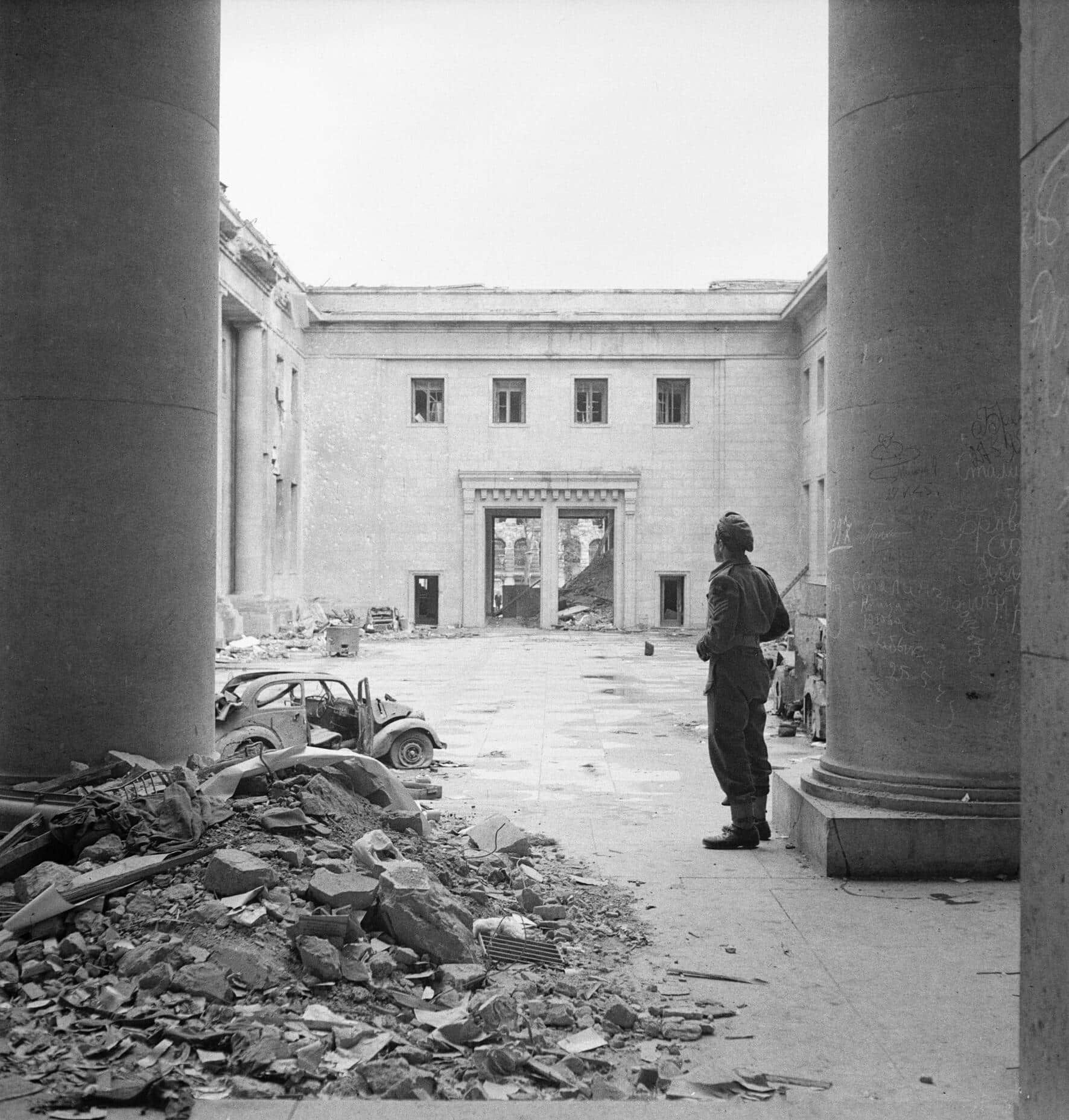
The Soviet plan of unleashing an immense artillery barrage on the Reich Chancellery was forgone, as infantry made their way into the building and a search squad – led by a Colonel named Ivan Klimenke, who had been tasked with finding Hitler’s body – quickly followed in their wake.
General Berzarin, head of the 5th Shock Army, had promised that any soldier who found Hitler’s body would be awarded the gold star of the Hero of the Soviet Union. Yet, despite the Reich Chancellery being in the Soviet 5th Shock Army sector, a unit of SMERSH military intelligence attached to the 3rd Shock Army soon arrived to take over the search for the Nazi leader.
Although this detachment was overseen by Lieutenant General Aleksandr Anatolievich Vadis – the Chief of the SMERSH Directorate of the 1st Belorussian Front – neither Berzarin or his superior would be made aware of the findings regarding Hitler’s death.
That morning, the Pravda newspaper had already claimed that the announcement made by the German defenders that Hitler was dead was a fascist trick. The question of the Nazi leader’s fate had taken on huge political importance – that the Soviets sought to urgently address. But in their own unique way.
The SMERSH detachment was – and the prisoners gathered in the Führerbunker and Chancellery taken to the Reich Institute for the Blind on Oranienstrasse for interrogation.
The lack of immediate success in finding Hitler’s corpse would lead to Stalin sending an NKVD general to take over the operation.
A veil of secrecy would be thrown over the search – as Stalin sought to continue the threat of internal and external enemies that had proven so vital to his system of control. Maintaining a stranglehold over the narrative until it could be turned to work in his favour – by exacerbating rumours that the Nazi leader had fled to the West and implicate the British and Americans in his escape.
On May 5th, the bodies of Adolf Hitler and Eva Braun were eventually discovered after interrogations of prisoners and a thorough search of the Chancellery gardens.
Two charred corpses were exhumed and removed. With Hitler’s teeth identified from his dental records.
–
To learn more about the circumstances surrounding Adolf Hitler’s suicide, have a look at our Mythbusting Berlin piece…
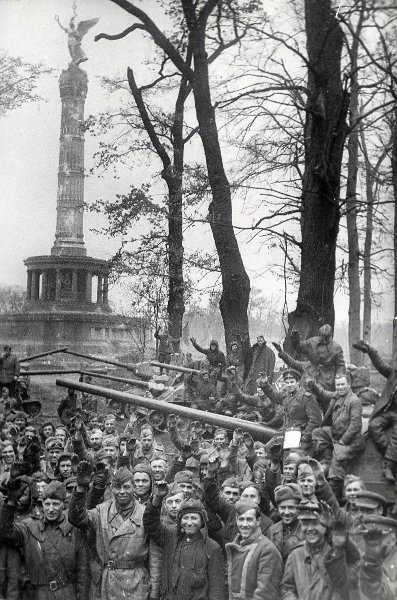
When the Berlin Strategic Offensive Operation finally ended, the Soviet tally for losses was measured at 304,887 killed, wounded, and missing, between April 16th and May 2nd. The combined three Fronts (1st and 2nd Belorussian, and 1st Ukrainian) counted 480,000 prisoners, with around 70,000 from Berlin – and claimed around 460,000 killed.
The round up of combatants in Berlin would see long columns of men led out of the city, with the 1st Belorussian Front gathering its prisoners in the open chalk mines of Rüdersdorf, before they were sent onwards to the labour camps of the Soviet Union. The Red Army would also round up anyone in uniform or that looked remotely official and march these men to Tempelhof airport before they were sent onwards to the Landsberg-on-Warthe prison camp.
Soviet consolidation of the city was quick – and as swiftly as military units had arrived in the city, their departure would be just as sudden.
The Polish formations in the city would withdraw at around noon on May 2nd – to regroup in the city of Nauen. But not before men of the First Polish Army flew the red and white flag on the Siegessäule in Berlin’s Tiergarten and on the Brandenburg Gate.
Marshal Konev’s 1st Ukrainian Front would draw down from the city immediately on May 2nd to head south and engage German Army Group Centre in Czechoslovakia – in conjunction with the 2nd and 4th Ukrainian Fronts.

More than 400 Soviet servicemen would be awarded the status of Hero of the Soviet Union for their actions during the battle of Berlin. However, in a reflection of the true inequality of the Stalinist system, some groups would be automatically excluded.
Particular ethnicities were forbidden from attaining this coveted title – such as Chechens, Kalmycks, and Crimean Tatars – as it was not allowed for any member of a group condemned to exile to be rewarded.
An accurate count of the number of civilian deaths over these 17 days is impossible – as the city administration collapsed during the fighting. However, post-war research suggests at least 20,000 deaths that could be attributed to the battle – not counting the record number of suicides in the city in the month of April.
When the fighting finally stopped, the city was in ruins – with an estimated 600,000 apartments destroyed. The Reichbank in Berlin was also plundered by the Soviet NKVD and 2,3889 kilos of gold removed, along with twelve tons of silver coins and millions of banknotes from countries the Nazis had occupied.
By far the most controversial tally of the period would be that of the number of victims of rape at the hands of the city’s Soviet liberators.

From analysis of contemporary hospital reports and a surge in the number of abortions, it is estimated that up to two million German women were raped during the last six months of the the Second World War – with up to 100,000 of them in Berlin.
Milovan Djilas, head of the Yugoslav Military Mission to Moscow during WWII would quote the Soviet leader’s opinion of the widespread vengeance inflicted on the local population by Red Army soldiers in his book ‘Conversations with Stalin’. With the Soviet Generalissimo saying: “Can’t you understand it if a soldier who has crossed thousands of kilometers through blood and fire has fun with a woman or takes a trifle?”
Without a doubt, alcohol and even dangerous chemicals seized from laboratories would play a major factor in the violence.
But for many Red Army soldiers, revenge would be the ultimate motivation.
Revenge for four years of relentless and unforgiving conflict.
Revenge inflicted on the men and women in uniform who would fight and die to defend Nazi Germany and Hitler’s regime. But also on a population that would soon come to know a different kind of tyranny – in the form of Soviet liberation.
The deathly reek of Stalinist utopianism. Embraced by many, and inflicted upon all.
–
It would take another six days before the victorious powers would gather in Berlin to formalise the capitulation of Nazi Germany. At an engineering school in the city suburb of Karlshorst.
With the British, American, Soviet, and French representatives meeting as equals in victory – and allies.
At least for the time being.
**
Our Related Tours
Want to learn more about the Battle of Berlin? Check out our Battle of Berlin tours to explore what remains of this important urban battlefield.
To learn more about the history of Nazi Germany and life in Hitler’s Third Reich, have a look at our Capital Of Tyranny tours.
Bibliography
Beevor, Antony (2003) Berlin: The Downfall 1945 | ISBN 978-0-14-028696-0
Hamilton, Aaron Stephan (2020) Bloody Streets: The Soviet Assault On Berlin | ISBN-13 : 978-1912866137
Kershaw, Ian (2001) Hitler, 1936–1945: Nemesis | ISBN 0-393-04994-9
Le Tissier, Tony (2010) Race for the Reichstag: the 1945 Battle for Berlin | ISBN: 978-1848842304
Le Tissier, Tony(2019) SS Charlemagne: The 33rd Waffen-Grenadier Division of the SS | ISBN: 978-1526756640
Mayo, Jonathan (2016) Hitler’s Last Day: Minute by Minute | ISBN: 978-1780722337
McCormack, David (2017) The Berlin 1945 Battlefield Guide Part I the Battle of the Oder-Neisse | ISBN: 978-1781556078
McCormack, David (2019) The Berlin 1945 Battlefield Guide Part II The Battle of Berlin | ISBN: 978-1781557396
Moorhouse, Roger (2010) Berlin at War | ISBN: 978-0465028559
Ryan, Cornelius (1966) The Last Battle | ISBN 978-0-671-40640-0
Sandner, Harald (2019) Hitler – Das Itinerar, Band IV (Taschenbuch): Aufenthaltsorte und Reisen von 1889 bis 1945 – Band IV: 1940 bis 1945 | ISBN: 978-3957231581
Shirer, William L. The Rise and Fall of the Third Reich | ISBN 978-1451651683.

